Swimming Football Jigs

by Russ Bassdozer
This shows and tells product photos, product descriptions and
information for the lure models and colors that are (or have
been) available at BassdozerStore.com. Not all models and colors
shown are currently available, and exact specifications are
subject to change.
Note: Some of the following configurations may not all be
currently in stock. Some may be sold out at this time. Please
check online at www.BassdozerStore.com
for current availability of specific items below. Thank you for
your business.
There's a renaissance of renewed interest in jig fishing the
past few seasons. It's in large part due to top BASS and FLW pros
who have been throwing more and different jigs than ever before.
I'm not really talking about your father's flipping jigs either.
There's a funny scene in the movie titled Forest Gump where
the character Bubba is reciting to Gump all the different ways
that shrimp may be served. The list seems to never end is the
funny part. Likewise with jigs, there are endless ways to present
jigs to fish - flipping jigs, Arkey jigs, finesse jigs, tube
jigs, shakey jigs, wacky jigs, stand up jigs, darter jigs, jig'n
worms, jig n' grubs, jig heads for swimbaits, jigs with spinners
under their chins, Slider jigs, float'n fly jigs, hair jigs,
bulky softball jigs and on and on.
Two jig styles that pros have been using more often in recent
years are: 1) swimming jigs and 2) football jigs. Many (not all)
of the pros have really only started using these jig styles
recently, but are doing swell with them, and their successes have
not gone unnoticed by the ranks of avid bass anglers worldwide.
Swimming Jigs
One pro angler in particular, Tom Monsoor from Wisconsin has
dominated the north central regional tournaments whenever he
fished them with his swimming jigs over the past decade. Some
sources cite Monsoor tallied 100 wins with swimming jigs in
regional events. When Monsoor stepped up to the national pro tour
in 2004, he took his Wisconsin swimming jigs with him. Monsoor
stuck several top finishes in quick order with his swimming jigs.
That caused a panic and herd reaction among other top BASS and
FLW pros who rushed to add swimming jigs to their bag of tricks.
Indeed, pros that tried swimming jigs (which were fairly new to
many of them) did quite well in top events from that time on to
the present.
Today, nation-wide swimming jig fever has cooled down. As
Monsoor's win streak tailed off, swimming jig popularity ebbed
also. It probably peaked a few years back (in 2004-2005).
Nevertheless, swimming jigs for bass are here to stay, and it is
fair to say it really wasn't done much before Monsoor.
Football Jigs
Another region, the far western USA, is the cradle of football
jig fishing. I don't know who or how it first started, but the
deep clear canyon lakes of Arizona, Utah, Nevada, New Mexico and
Southern California are considered the domain where heavy
football jigging flourished for bass fishing.
For instance, back in 1995, top pro Gary Yamamoto won the
West's biggest event - the US Open in Las Vegas - with a one
ounce football jig, a technique largely unknown to pros outside
the far west until recently.
In just the last couple seasons on the top BASS and FLW tours,
the football jig has become an "overnight success" as
one of the winning-est tactics today. Part of the reason is that
top pro tour schedule timing has shifted the past couple seasons
to include more post-spawn events when fish drift deeper after
the spring. So it is no longer "prime time" for the
shallow water flipping jig bite by early summer, and pros are
finding they have to go deeper to win post-spawn events the past
couple seasons. In fact, pros overall are turning more and more
to deepwater methods throughout the entire season (not just
during post-spawn events) in order to access untapped deepwater
bass populations, and they're discovering the heavy football jig
is one of the best deepwater lures.
Will the current popularity of the football jig only last a
season or two like so many other hot tactics that spurt then
wither? Will intense interest in the football jig wane like with
the swimming jig? It's too early to say. Right now the football
jig is hot, at least until the next hot thing supersedes it.
But one thing's for sure, neither the Western style football
jig nor the Wisconsin style swimming jig will ever slip back into
being a regional tactic anymore. Both swimming jigs and football
jigs work too well and anglers everywhere know about them now. So
they're here to stay.
Swimming Football Jigs
The reason pros are going deeper, Tom Monsoor says:
"Shallow water weeds and wood are the choicest types of
spots that fish favor on any body of water, and practically every
anglers knows that. I am convinced these shallow fish in prime
spots know all about anglers, boats and baits. They get peppered
with lures, have gone through catch and release. They've learned
to bypass the bad presentations and turn down the
less-than-perfect swimming jigs. On the other hand, the deeper
you fish, the more hook-ups you will get even with a less than
perfect lure or presentation. Fish are dumber deeper. Find fish
deep, and they don't see a lot of lures down there. You don't
always need the perfect lure to get fish down deep."
Monsoor's comments really set the stage for something you
hardly ever hear about (and I've even read articles that say it
won't work). That is swimming football jigs down deep. Football
jigs are "supposed" to be bottom-bounced or dragged
across bottom in deep water. Swimming jigs are
"supposed" to be kept moving up near the surface in
thick, shallow vegetation. But swimming football jigs combines
those two into a deep swimming presentation.
Honestly, swimming football jigs is fairly simple and
effective. It combines 1/2, 3/4 or 1 ounce football jigs with
baitfish-colored skirts and grub tail trailers used with a
swimming (as opposed to bottom-bouncing) retrieve. Another
"melding" of these techniques you may say are that
these football jigs don't have a heavy wire flipping caliber
hook. They have a medium (yet still strong) hook that helps set
the hook with a swimming retrieve. For whatever reason, a
swimming jig retrieve works best with a long cast. Some say in
shallow grassy areas, the long cast with a swimming jig is needed
not to alert fish to the angler's presence. But there's more to
it than that because the long cast also gets more strikes in deep
water swimming football jigs. Who knows why but it's true that a
long cast is best when swimming jigs.
Another helpful feature for swimming jigs is these footballs
don't have the thick, super-stiff brushguards often found on
football jigs. Again, the brushguard used here helps fish hook
themselves when they hit these football jigs on the end of a long
distance cast.
No, these are not finesse jigs - nor are they flipping jigs.
For instance, the gear I favor for them is either a Falcon Expert
EC-7-MH rod (for the 1/2 oz size) and a Falcon Expert EC-7-H for
the 3/4 and 1 ounce swimming football jigs. Both rods I use 16
pound test Yamamoto Sugoi gray fluorocarbon line with Shimano
Chronarch 200 reels. So that's certainly not finesse fishing, but
the medium/heavy hook wire and fiberguard are excellent in
swimming jig situations with medium/heavy (as opposed to
flipping) strength gear.
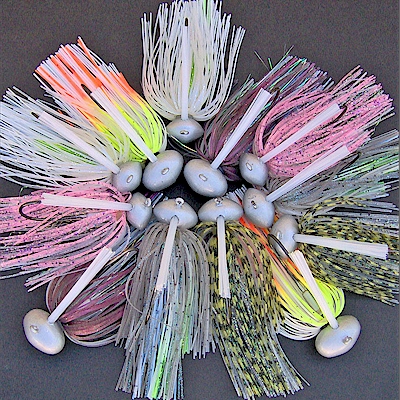
Swimming Football pile-up! 1/2, 3/4 and 1 ounce sizes. Same 5/0
hook in all.
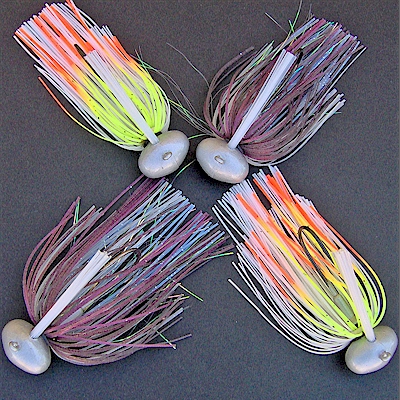
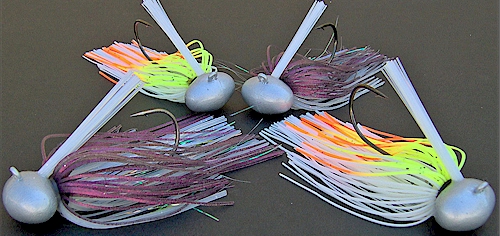
1 oz Swimming Football Jigs. Purple Haze and Smallie
Special skirts.

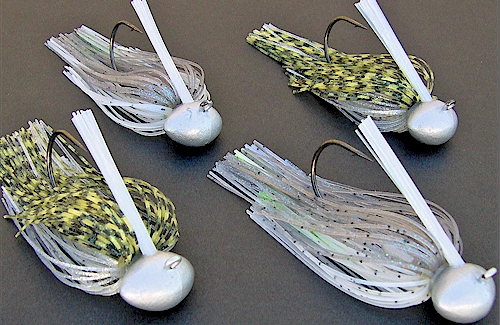
3/4 oz Swimming Football Jigs. Green Shiner and Chartreuse
Shad skirts.
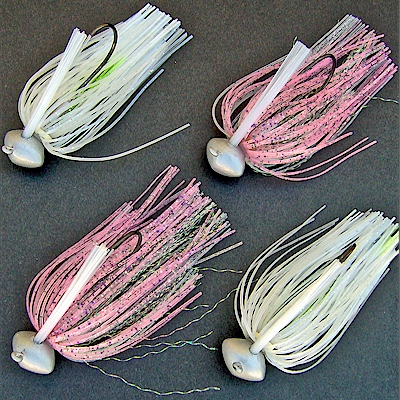
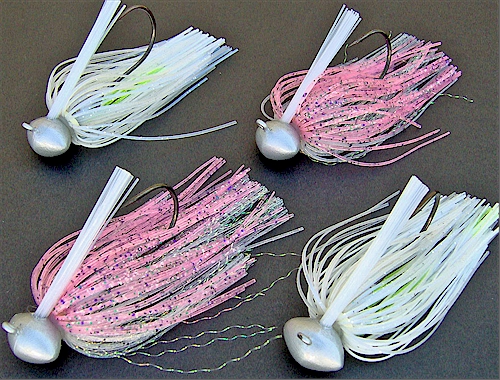
1/2 oz Swimming Football Jigs. Spot Special and Pearl Blue
Chartreuse skirts.
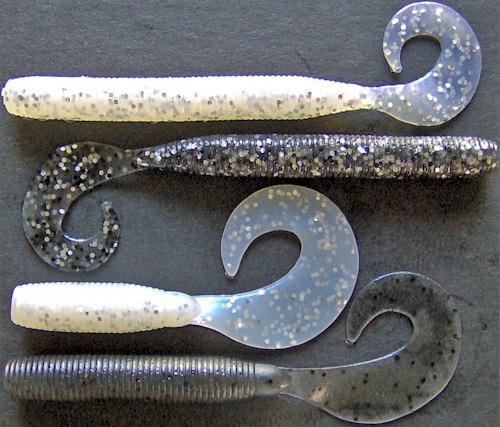
Swimming Football Grubs. Just like a coin has a head and a tail,
so too must a jig head always have a tail or trailer. Shown above
are Gary Yamamoto Custom Baits 2-series 6" grub tails in
color 031 (top); 2-series grub in color 177 (second); 18T-series
grub in color 031 (third); and 19T-series grub in color 150.
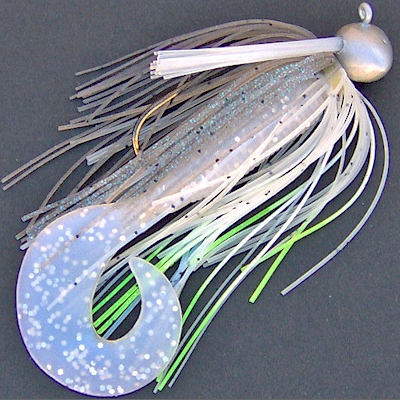
1/2 oz Football Jig ~ Chartreuse Shad ~ 18T-031 Yamamoto Grub
Tail
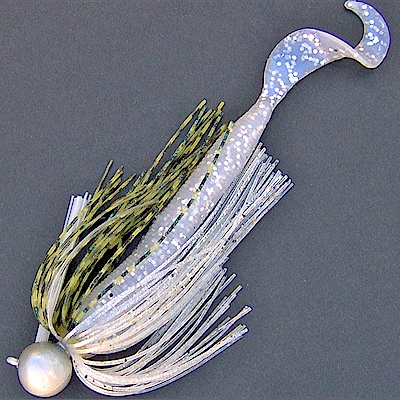
3/4 oz Football Jig ~ Green Shiner ~ 2-031 Yamamoto Grub Tail
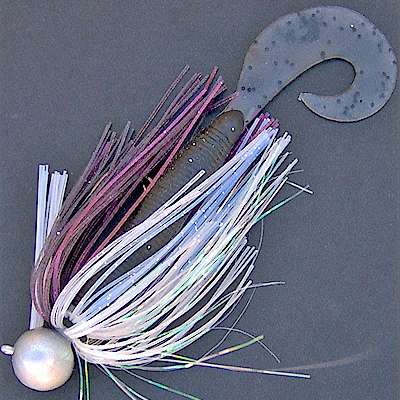
1 oz Football Jig ~ Purple Haze ~ 19T-150 Yamamoto Grub Tail
Swimming a baitfish pattern jig is a different presentation
and gets a different reaction from fish compared to slowly
bouncing the bottom with a black blue or brown purple or dark
color jig. The swimming football jig is a faster, flashier style
of jig fishing. Why not give these swimming football jigs a try
today? You'll be glad you did.
Tips for the Swimming Football Technique
It is a misconception that football jigs need to be used RIGHT
ON THE VERY BOTTOM. I've even come across articles claiming you
can't swim football jigs, but that's not true. Yes, these
football jigs can be swam in very close proximity to the bottom,
but the best approach is so the jigs rarely touch bottom except
when YOU momentarily pause of purposely mend slack line to the
jig that allows the jig to sink to seek the bottom in order so
you may adjust the depth ABOVE BOTTOM at which you are making
your swimming presentation. Otherwise, you really don't need to
hit bottom at all, except to stop and let the jig touch down
every so often to make sure you are near but not on the bottom.
This is the case when you are retrieving down a downhill bottom
contour. You will occasionally need to pause to let the jig sink
to hunker close to the bottom. But once it touches down, start
swimming it again.
On an uphill bottom contour, you'll need to do the opposite.
Quicken the retrieve until the football jig can no longer be felt
bouncing the bottom. One way to help visualize this is to
consider the football jig is like a jet plane taking off on a
runway. You want the jig to get airborne (start swimming) and you
need to accelerate the retrieve enough so that the jig takes off
from bottom. Unlike the jet plane however, you want the jig to
ideally hover close to bottom - with minimal subsequent
touch-offs just to make sure the jig hasn't risen too high. You
want to be off bottom but tracking close to it.
What happens when you are swimming along and there's a sudden
rise or obstacle such as a bush, a boulder, a ridge shelf jutting
up higher than the rest of the terrain is that the swimming
football jig will begin to clutch, bounce off and stutter over
and through the object. As the football jig bulldozes its way
through and past the object, it will start to get that
"floating feeling" as it starts to swim smoothly again.
That instant when it clears the obstruction as the grabby, snaggy
feel turns into a floating swim feel is a high percentage strike
point. As the jig bumbles through and pulls clear of whatever's
down there, expect it to get belted hard.
Drifting Football Jigs in Current
One other tip, if the water you fish has current or flow,
these same football jig excels when cast cross current and
allowed to dead drift down current. Actually, cast slightly
upcurrent, starting at a 45 degree angle upcurrent (depending on
current speed and depth). The current sweeps the jig back down at
you. The jig will sink down and start rolling and dragging along
bottom if you don't do anything. If you start reeling in just a
little line, the jig will perk up and start methodically bouncing
bottom instead of rolling or dragging. If you increase the pace
to wind in just a little more line, the jig will reluctantly
start to "take off" from the "runway" and
become temporarily "airborne." Like a plane that may be
overloaded too much and cannot make it off the runway - gravity
will return the jig to bottom occasionally until it is
perpendicular to you (directly in front of you) in the current
when water flow pressure neutralizes and overrides gravity's
force, your jig should float away from bottom! That is often the
moment when the connection is made between fisherman and fish,
when the jig is no longer bouncing bottom, but floating freely
above it buffeted by the swirling of the current. The jig is
fairly neutral for an instant there, like an astronaut in a
weightless environment! What happens next instant is the jig
switches to being downcurrent from you. Immediately the jig does
an about-face 180 turn and starts rising in the current. This
sudden rise is a strike trigger. You can't really do it with the
rod tip or with reel and line manipulation. It is only the
current and the dead drifting tactic that makes these strike
trigger moments possible. If there is any fish-holding boulder,
hump, wood jam or whatever may hold fish, you really want to
orchestrate the instant of the 180 turn-around and rise to happen
right there.
So, if you are going to be fishing current a bottom-bouncing
approach like this is a good choice for these football jigs for
clean (weed-free) sand, shellfish and rock bottoms, channels or
whatever (except weedy bottoms). You will need some current flow
from mild to strong, which can be matched with the 1/2, 3/4 and 1
oz weights depending on current flow. But keep in mind, you will
rarely catch any fish on the bottom-bouncing part when the jig is
coming down current. That's only the part used to set up and
prepare for the free float when it gets directly in front of you,
the turn-around and rise. Nor will you get many strikes
once the jig drifts past that point and falls down current from
you.
The above skirts and jig heads are available at
BassdozerStore.com.
Please enjoy! |
